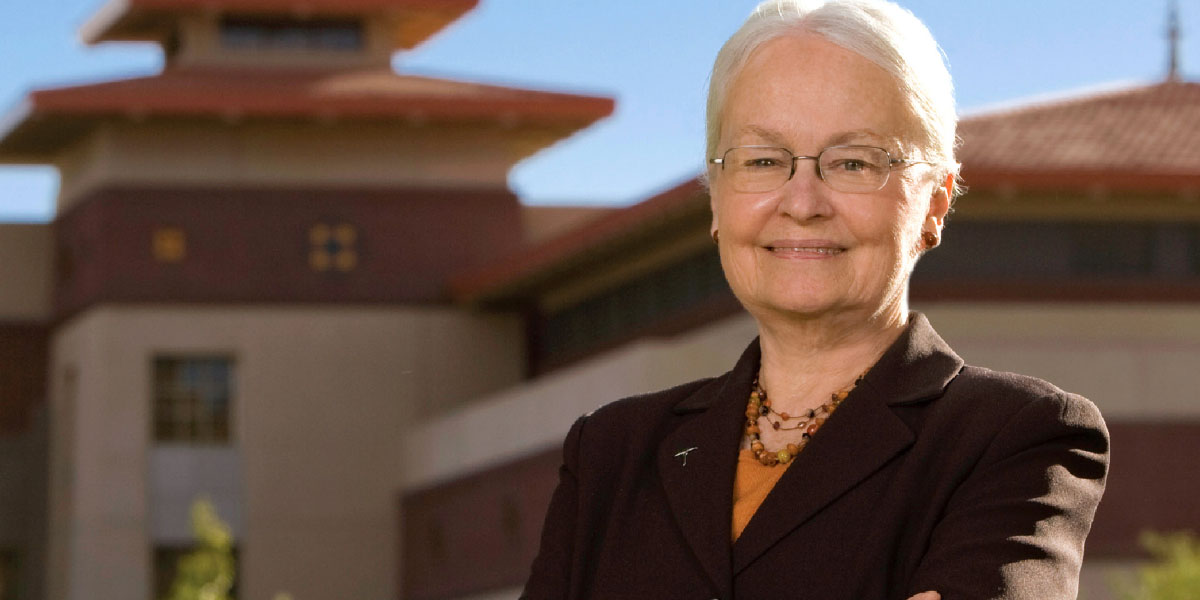
Diana Natalicio was named president of the University of Texas at El Paso (UTEP) 30 years ago. In her long and distinguished career, her deepest commitment has been to provide all residents of the Paso del Norte region access to outstanding higher education opportunities. Progress has been remarkable. Her leadership has resulted in enrollment growth from 15,000 to more than 25,000 students, 90 percent of whom come from the surrounding region; and 80 percent are Hispanic.
During Natalicio’s tenure, UTEP’s annual budget has increased from $65 million to more than $500 million; the university is now designated as a research/doctoral university recognized nationally for the excellence and breadth of its academic and research programs; and annual research expenditures have grown from $6 million to nearly $95 million.
Much of this activity reflects the mission of the University of Texas at El Paso, which is “dedicated to the advancement of the El Paso region through education; creative and artistic production; the generation, interpretation, application, and commercialization of key discoveries; and the dissemination of knowledge. UTEP embraces its role as an intellectual, cultural, and socioeconomic asset to the region, offering programs to meet human resource needs and contributing to its prosperity and quality of life.”
Natalicio noted, “At its heart, this is a transformation in our attitudes and aspirations for the future of the University of Texas at El Paso. We are a far more confident and ambitious university than ever before, and we are proud that our vision of becoming the first national research university with a 21st century student demographic has been realized.”
One of the defining elements in this transformation has been the successful quest to ensure that all talented young people in the surrounding region, whatever their ethnicity, gender, or socioeconomic backgrounds, have an authentic opportunity to achieve their highest educational aspirations. As a result, UTEP’s student population now reflects the region from which it draws 90 percent of its students—80 percent of whom are Hispanic, and more than 40 percent who report an annual family income of $20,000 or less.
“We’ve reached a real crisis in our country with respect to the education of individuals of modest financial means,” notes Natalicio. “In attempting to serve this region well, UTEP has become a national model for success in transforming the profile of a student population and fostering students’ social mobility.”
Natalicio answers the following questions to explain some of the ways in which UTEP has been able to align itself with the surrounding demographics and serve its population so well.
You’ve talked about El Paso being a “closed loop” or “ecosystem.” What role has collaboration played in fostering greater participation in higher education of Hispanic and low-resourced students—as well as connecting community and university efforts?
Collaboration has been a key to UTEP’s success. Eighty percent of our students are graduates of high schools in El Paso County, so it’s critically important that we work closely with those schools to ensure that our entering student population is well prepared for success at UTEP.
Moreover, since an estimated 75 percent of area teachers are graduates of the University of Texas at El Paso, we have the opportunity to contribute significantly to the educational quality of K–12 schools. We have a similar reciprocity of interests with El Paso Community College and, together, all three levels (K–12, EPCC, and UTEP) are aligning standards and expectations across the educational spectrum.
How does UTEP interact with potential students from Mexico, with the border so close by?
El Paso and Ciudad Juárez form a single metropolitan area of 2.5 million residents, two-thirds of whom live on the Mexican side of the international boundary.
When we think of the future economic development and prosperity of this binational region, it’s apparent that talent resides on both sides of the border, and we must do all we can to ensure that this talent isn’t squandered.
So, we reach out to students at Mexican high schools and universities in this region.
We’ve also built strong partnerships with a variety of Mexican institutions and organizations.
How do you go about attracting Hispanic faculty, and how does that kind of role model affect students who are mostly first generation?
Hispanics remain seriously underrepresented on the faculties of U.S. universities, and this disparity will become even more apparent as growth in the U.S. Hispanic population accelerates. With an 80 percent Hispanic student population, UTEP works hard to recruit and retain outstanding Hispanic faculty members who not only provide high-quality educational opportunities for our students but also serve as role models for them.
The percentage of Hispanic faculty at UTEP is nearly 30 percent, far higher than the single-digit national average. In addition, we now offer 22 doctoral degree programs, which have enabled UTEP to become a major source of newly minted Hispanic faculty who are well prepared to help diversify other universities’ faculty ranks.
With such a focus on access, how do you also help ensure that first-generation students complete their degrees and are prepared for their first jobs?
Preparing our students, especially first-generation students of extremely modest financial means, has been a high priority for UTEP over the past 30 years, and the success of our work has brought us national recognition. We recognize that we have a responsibility to be a “full-service” university, providing students a broad range of services that might not be necessary in more affluent settings, but which are absolutely critical to the success of our students.
Nearly all our students work either part or full time while enrolled, and when they experience challenges to degree completion, the root cause is rarely academic. It invariably relates to money: a job loss or transfer, a health issue, auto repairs. Low-income families have no cushion with which to respond to such unexpected issues; and we have to be sure that we are prepared to provide good advice, and often even short-term loans, to get them through to their next paycheck.
Why do you think that UTEP has been fertile ground for growth, access, and research innovation?
UTEP’s success has largely been the result of devoting time and expertise to understanding the ecosystem in which we work, and then developing strategies to build on our assets and manage our challenges. Although we have often been told that universities must decide whether they will be access or excellence focused, we know that access and excellence are not only compatible, but can be successfully leveraged to our students’ great benefit.
The record shows that we have achieved success by creating our own model of higher education rather than emulating models that may or may not work in other settings. That takes courage and tenacity, because most national and state metrics to assess institutional performance are tied to more traditional settings, whose ecosystems are completely different from ours.
What changes and challenges are you planning for in the next decade?
I’m confident that UTEP will continue to build on the success we’ve achieved over the past 30 years, and serve as a model for all the many universities across the U.S. that seek to authentically serve their regions by playing the cards they are dealt, rather than wishing for another hand.
CAROLE SCHWEITZER is editor in chief of Business Officer.



